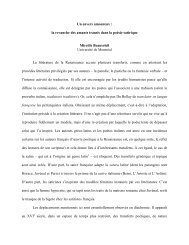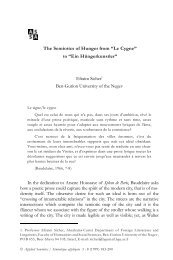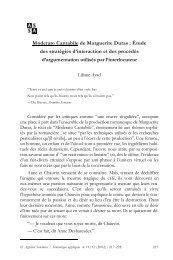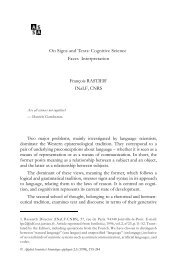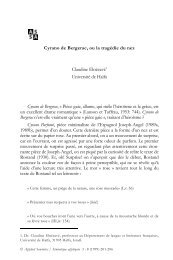the target text. To answer the question I asked in the introduction, “Is culture translatable?”, it seems not, or only sometimes. The two translators managed to find translation solutions that partially convey the source cultural message in the target text in some cases. However, on a whole, the translation of CSIs is rarely satisfying because of the level of entropy it implies. Is it utterly elusive to aim at carrying the source CSIs and their connotations in the target text? I would like to argue that it would not be if adding extra-textual information, such as the translator’s note, was not seen so negatively in the literary world. Some argue that the translator is not the author and that he therefore should not interfere with the text by adding information that was not originally in the source text. Others believe such a view leaves the translator powerless, without any authority on the source text which is his raw material for creation, and therefore call for a wider use of notes so as to improve the target readership’s comprehension. The status of the translator is slowly improving as it seems he is moving from the invisibility described by Venuti to a gradual public recognition. It is quite common to find a translator’s preface at the beginning of a translated work nowadays. Unfortunately, it seems that the act of translation will remain particularly frustrating if it is expected of translators to create an optimum level of comprehension without relying on extra-textual tools. Moreover, what this study has shown is that translators are individuals guided mostly by their intuition and personal motivations rather than by the theoretical considerations of Translation Studies researchers. There is therefore a large gap between the theories pertaining to the translation of culture in literature and the actual practice of translators. This gap is the result of a failure to identify the many challenges (linguistic, cultural but also ideological) that make every translation situation unique. 16
BIBLIOGRAPHY AIXELA, Javier Franco, “<strong>Culture</strong>-Specific Items in Translation”, Translation, Power, Subversion, Ed. Román Álvarez and M. Carmen-África Vidal, Clevendon, Multilingual Matters, 1996, p. 52-78. AUBERT, Jacques, Introduction à l’esthétique de <strong>James</strong> <strong>Joyce</strong>, Paris, Didier, 1973. - - - , <strong>Joyce</strong> avec Lacan, Paris, Navarin, 1987. BALLARD, Michel, La traduction de l’anglais au français, Paris, Nathan, 1994. BASSNETT, Susan, Translation Studies, London, Routledge, 1991. CATFORD, John, A Linguistic Theory of Translation, London, Oxford UP, 1965. DEMING, Robert, <strong>James</strong> <strong>Joyce</strong>: The Critical Heritage, London, Routledge, 1970. GOODENOUGH, Ward, “Cultural Anthropology and Linguistics”, Language in <strong>Culture</strong> and Society. A Reader in Linguistics and Anthropology, Ed. Dell Hymes, New York, Harper, 1964, p. 36-68. HAYMAN, David and Ira NADEL, “<strong>Joyce</strong> and the Family of Emile and Yva Fernandez: Solving a Minor Mystery”, <strong>James</strong> <strong>Joyce</strong> Quarterly, 25, 1987, p. 49-57. HERMANS, Theo, The Manipulation of Literature, London, Croom Helm, 1984. HEWSON, Lance and Jacky MARTIN, Redefining Translation: the Variational Approach, London, Routledge, 1991. HOLMES, <strong>James</strong>, Translated! Papers on Literary Translation and Translation Studies, Amsterdam, Rodopi, 1994. JOYCE, <strong>James</strong>, “The Dead”, Dubliners, 1992 ed., Harmondsworth, Penguin, 1914, p. 175-225. - - - . “Les morts”, Gens de Dublin, Trans. Yva Fernandez, Paris, Plon, 1926, p. 201-50. - - - . “Les morts”, Dublinois, Trans. Jacques Aubert, Paris, Gallimard, 1974, p. 280-350. - - - . Ulysse, Trans. Jacques Aubert, 2004 ed., Paris, Gallimard, 1922. NEWMARK, Paul, A Textbook of Translation, London, Prentice Hall, 1988. SNELL-HORNBY, Mary, Translation Studies. An Integrated Approach, Amsterdam, John Benjamins, 1988. TOURY, Gideon, Descriptive Translation Studies and Beyond, Amsterdam, John Benjamins, 1995. VENUTI, Lawrence, Rethinking Translation. Discourse, Subjectivity, Ideology, London, Routledge, 1992. - - - , The Translator’s Invisibility. A History of Translation, London, Routledge, 1995. 1 For a history of the discipline, see: Susan BASSNETT, Translation Studies, London, Routledge, 1991. 2 John CATFORD, A Linguistic Theory of Translation, London, Oxford UP, 1965, p. 20. 3 See: Robert DEMING, <strong>James</strong> <strong>Joyce</strong>: The Critical Heritage, London, Routledge, 1970. 4 For a detailed account of the links between the <strong>Joyce</strong> and Fernandez families, see: David HAYMAN and Ira NADEL, “<strong>Joyce</strong> and the Family of Emile and Yva Fernandez: Solving a Minor Mystery”, <strong>James</strong> <strong>Joyce</strong> Quarterly, 25, 1987, p. 49-57. 5 <strong>James</strong> HOLMES, Translated! Papers on Literary Translation and Translation Studies, Amsterdam, Rodopi, 1994, p. 71. 6 Gideon TOURY, Descriptive Translation Studies and Beyond, Amsterdam, John Benjamins, 1995, p. 10. 7 Ward GOODENOUGH, “Cultural Anthropology and Linguistics”, Language in <strong>Culture</strong> and Society. A Reader in Linguistics and Anthropology, Ed. Dell Hymes, New York, Harper, 1964, p. 36. 8 Lance HEWSON, and Jacky MARTIN, Redefining Translation: the Variational Approach, London, Routledge, 1991, p. 123. 9 Mary SNELL-HORNBY, Translation Studies. An Integrated Approach, Amsterdam, John Benjamins, 1988, p. 42. 17





